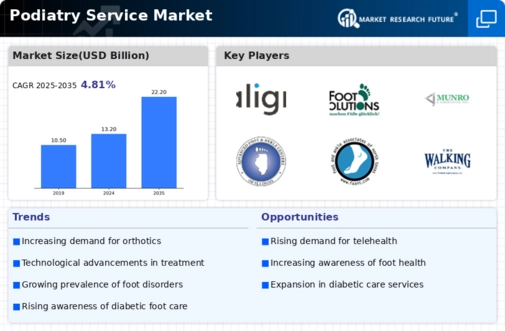Market Growth Projections
The Global Podiatry Service Market Industry is projected to experience substantial growth over the coming years. In 2024, the market is expected to reach 13.2 USD Billion, with a forecasted increase to 22.2 USD Billion by 2035. This growth trajectory indicates a robust demand for podiatric services, driven by factors such as an aging population, rising prevalence of foot disorders, and advancements in technology. The anticipated CAGR of 4.81% from 2025 to 2035 further underscores the industry's potential for expansion. These projections highlight the importance of strategic investments and innovations within the podiatry sector.
Increased Awareness of Foot Health
There is a growing awareness of foot health among the global population, which significantly impacts the Global Podiatry Service Market Industry. Educational campaigns and health initiatives aimed at promoting foot care are becoming more common, leading to increased patient engagement. This heightened awareness encourages individuals to seek professional podiatric services for preventive care and treatment of existing conditions. As a result, the market is expected to grow, with projections indicating a rise to 22.2 USD Billion by 2035. This trend underscores the importance of proactive foot health management and its implications for overall well-being.
Rising Prevalence of Foot Disorders
The Global Podiatry Service Market Industry experiences a notable surge due to the increasing prevalence of foot disorders such as diabetes-related complications, plantar fasciitis, and bunions. As the global population ages and lifestyle-related health issues rise, the demand for podiatric services is expected to grow. In 2024, the market is projected to reach 13.2 USD Billion, reflecting a heightened awareness of foot health. This trend suggests that more individuals are seeking specialized care, thereby driving the growth of the industry. Furthermore, the integration of advanced diagnostic tools enhances treatment efficacy, further propelling market expansion.
Aging Population and Lifestyle Changes
The aging population and shifting lifestyle patterns are key drivers of the Global Podiatry Service Market Industry. As individuals age, they become more susceptible to foot-related ailments, necessitating specialized care. Additionally, sedentary lifestyles and increased obesity rates contribute to a rise in foot disorders. This demographic shift is likely to result in a higher demand for podiatric services, as older adults seek treatment for conditions such as arthritis and neuropathy. The market's growth trajectory reflects these changes, with an expected increase in value as more individuals prioritize foot health in their overall wellness strategies.
Technological Advancements in Podiatry
Technological innovations play a pivotal role in shaping the Global Podiatry Service Market Industry. The introduction of advanced imaging techniques, minimally invasive surgical procedures, and telemedicine solutions enhances patient care and accessibility. For instance, the use of 3D printing for custom orthotics has revolutionized treatment options, allowing for personalized solutions. As these technologies become more prevalent, they are likely to attract a broader patient base, contributing to market growth. The anticipated CAGR of 4.81% from 2025 to 2035 indicates that the industry is poised for sustained expansion, driven by continuous advancements in podiatric care.
Expansion of Podiatry Clinics and Services
The expansion of podiatry clinics and services globally is a significant factor influencing the Global Podiatry Service Market Industry. Increased investment in healthcare infrastructure and the establishment of specialized clinics enhance access to podiatric care. This expansion is particularly evident in urban areas, where demand for foot care services is rising. As more clinics open and offer a wider range of services, including preventive care and surgical options, the market is likely to experience substantial growth. This trend aligns with the overall increase in healthcare accessibility, which is essential for meeting the needs of diverse populations.
















